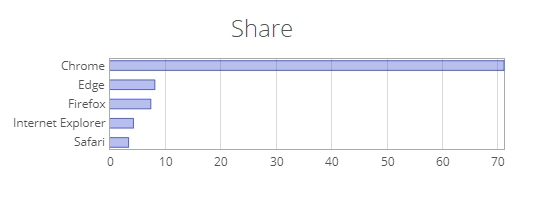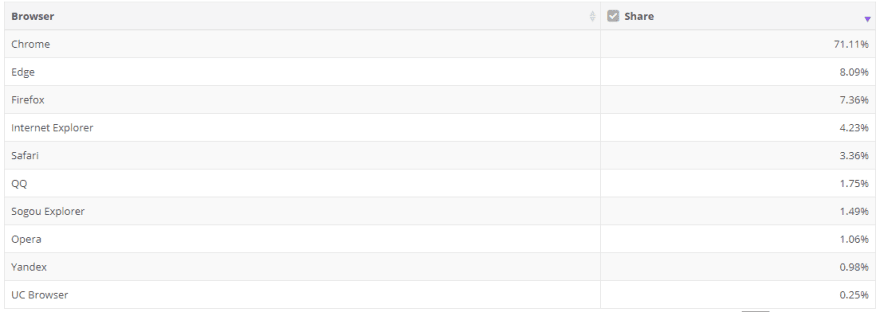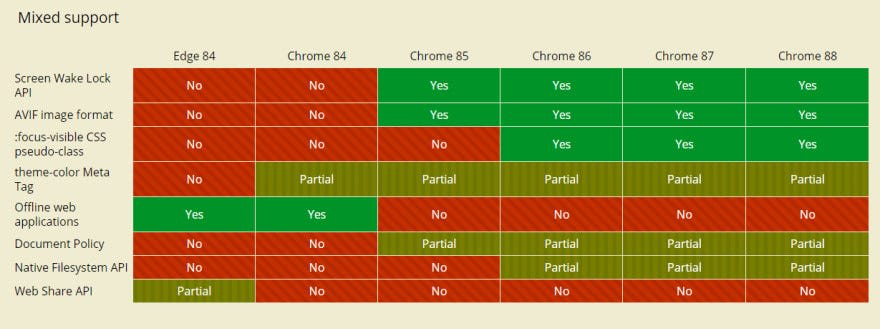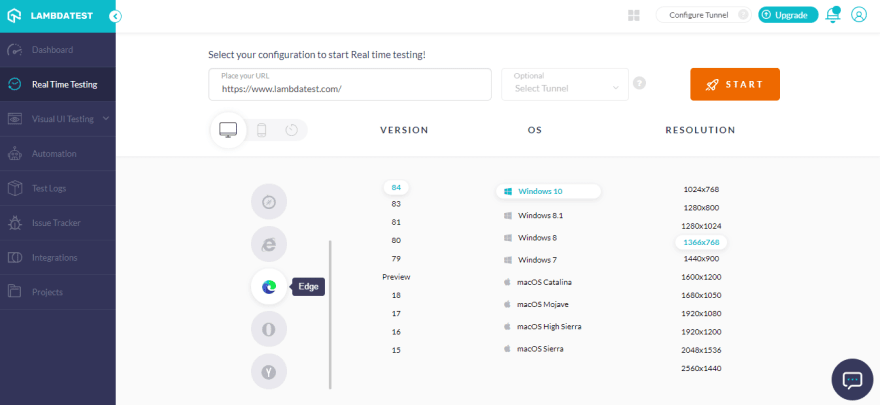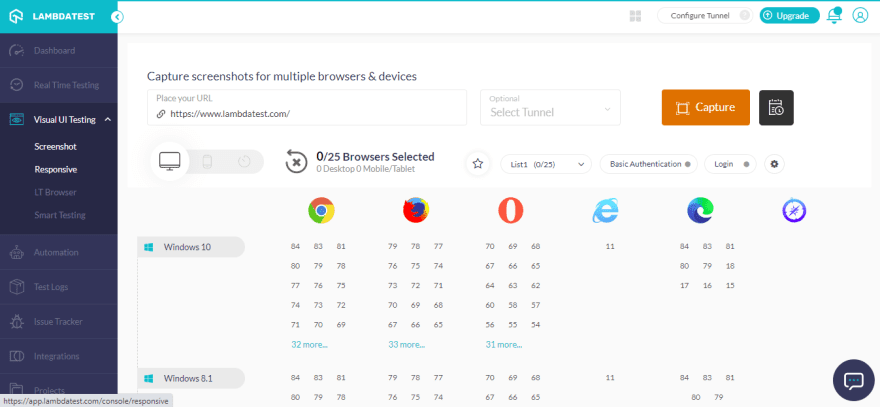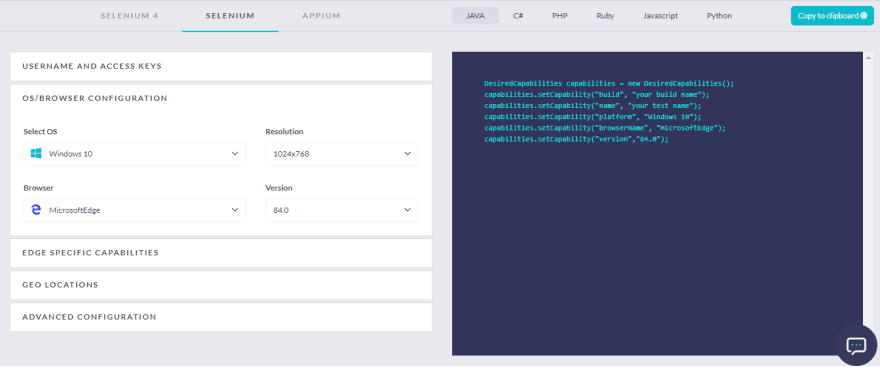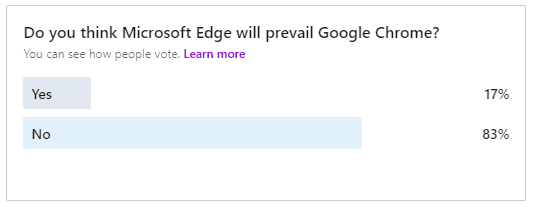
Kritika
Posted on September 21, 2020

Microsoft Edge, a long-forgotten soldier in the browser wars has been under a significant overhaul ever since it became Chromium-based. It is now taking the browser wars by storm after overtaking Mozilla firefox and becoming the second most used browsers. Yes, you heard it right!
The big question is-
Is your website ready for the new Chromium-based Microsoft Edge? Are you testing your website on the brand new Edge?
You probably were not very concerned about your website’s performance in Edge. Until now. Allow me to change your perception about testing your website on Microsoft Edge!
Why Must You Start Testing On Microsoft Edge?
Let me start with two simple yet crucial questions.
Which browser do you use the most?
If you are a part of the majority, it’s probably Google Chrome.
Which browser is the most efficient in your opinion?
Google Chrome is clearly the most popular browser, but the answer varies when we pop the second question. Despite having a majority of browser market share, Chrome has been infamous when it comes to user privacy, high memory & CPU usage. The latest developments and changes we’ve come across concerning Chrome are probably why the answers are inconsistent. When we talk about growth, Chrome has kind of hit a wall in those terms. Where do you go if you’re already at the top?
So many questions to ask and so little to offer. There’s a massive space for other browsers to pave into, and this is where Microsoft Edge is trying to claw its way back. Before we dive deeper into these changes, let’s take a moment to recognize how Edge has been inching its way to the top slowly but steadily, which, in turn, has added more fuel to the Edge vs Chrome war!
Based on the data provided by NetMarketShare, Microsoft Edge has beaten Mozilla Firefox in the race to become the second most-used web browser after Google Chrome.
Let’s journey back and look at the tale of Edge and how it shaped up to become what it is today to cause Edge vs Chrome.
Test your website or web app online for iOS browser compatibility. Perform seamless cross browser testing on the latest iPhone Simulator. Try for free!
Chronicles Of Microsoft Edge
After the long-overdue exile of Internet Explorer, Microsoft decided to rebrand IE and launch what we know today as ‘Microsoft Edge.’ This was way back in 2015 when Edge was released as a part of Xbox One and Windows 10. Subsequently, it was released for Android, iOS, and macOS in 2017 and 2019. Microsoft has been cautious about not repeating the mistakes it made with IE. Thus, Edge moved on from the legacy technologies that IE was based on, including ActiveX and BHO. Edge was designed to be all that IE was not, and it has been quite a journey.
The browser engine plays a vital role in rendering web pages and HTML documents over the internet for web browsers. For IE, Microsoft used Trident, and for Edge, they initially decided to go with its proprietary EdgeHTML using the Chakra JavaScript engine. In December 2018, Microsoft announced that they would be discontinuing the EdgeHTML engine, and Edge will be rebuilt and reintroduced as a Chromium-based browser. For the uninitiated ones, Chromium is an open-source and free software project owned by Google. Edge’s new build was previewed for Windows 7, 8, 8.1, and macOS in 2019. While many considered this step to be counterintuitive, Microsoft believed otherwise and went on to release Chromium-based Edge publicly in January 2020. Since then, the brand-new Edge has been rolled out as a part of the latest Windows update.
How Did Microsoft Edge Fare?
Edge was not received well by the general public initially. It was laughed at and proclaimed to be almost as slow as IE. Initial benchmarks were not a good sign and placed Edge on the slower side of the browsing world. On a brighter side, Edge performed better in the SunSpider benchmark as compared to other browsers but was still a lot behind in other benchmarks.
With the release of new builds and updates, Edge got better at benchmarks. In August 2015, the beta version of Edge 21.10532.0 scored 445 in the HTML5test (out of 555). These results were certainly encouraging enough for people to give Edge a chance, but there were complaints here and there. As Microsoft started rolling out Edge with Windows updates, people were miffed and went on to call Edge a ‘malware’!
In July 2020, there was a crash controversy when Edge crashed hard if users were setting Google as the default search engine. Surprisingly, Edge was not crashing when Bing was selected as the default search engine. Microsoft did solve the bug eventually and even contacted Google to look for a potential solution.
Amongst a lot of ups and downs, the introduction of Chromium into Edge is turning out to be a gamechanger for Edge. The fate of Edge seemed to have transformed entirely ever since the latest version was released. Let me give you an example.
I have always been a Chrome user as far as I can remember, apart from a few experiments with Firefox (which I wasn’t too happy with). So, I decided to try Microsoft Edge and try to make sense of the Edge vs Chrome war. I have been using Edge for the past two weeks, and trust me when I say this; I could not have been happier.
Here’s what it means to use the latest version of Microsoft Edge-
Signing up for a Microsoft account now means automatic account synchronization, including your history, bookmarks, passwords, etc. This is applicable even if you use Edge on a different device; you will still have access to all your data, which was a welcome change.
Thanks to Chromium, Edge is very similar to Chrome, and you won’t even realize that you have switched browsers (until you search something since Bing is still their default search engine).
Edge is now much faster than its previous versions.
Apart from the extensions already available in Microsoft’s store, it now allows users to use many extensions that were initially meant for Chrome users only.
Edge is now lighter, not a memory hog, and uses way fewer resources, including the RAM in your system compared to other Chromium-based browsers.
Edge has become much more efficient as a browser. As a bonus, the new Edge makes it easier to manage privacy settings. I was impressed to see how the ‘Strict’ privacy setting behaves essentially as an ad-blocker.
What About Google Chrome?
We have witnessed mixed reactions from the public when it comes to web browsers. Google Chrome has been the clear choice with a market share of over 70%. But it seems that people are not entirely happy with Chrome either.
In a report by ZDNet, Google engineers accepted that 70% of Chrome’s security issues are due to problems with the ‘codebase.’ These ‘codes’ were related to a plethora of security bugs and incorrect memory management. Both the predominantly used languages C and C++, were deemed unsafe by these engineers.
Before Chrome 80, Google has been facing a lot of flak for privacy violations by the Chrome browser, and 2020 has not exactly been the best year for them. The newly added ‘ScrollToTextFragment’ browser capability was deemed too invasive and a potential threat to user privacy. In other words, the purpose of this Deep Linking upgrade was to enable indexing of websites and link sharing based on a single word in a text and its position on a webpage. As pointed out by The Register this upgrade had the potential of exploiting our privacy and pose significant security threats.
Making matters worse, macOS users started seeing horizontal blues lines on their screen while using Google Chrome. In fact, Chrome was unable to render some of the most frequently used websites on macOS devices. Google even went on to confirm that macOS users were facing some serious glitches. Although there was a lot of back and forth between Apple and Google, it was still a major turn off for Mac users.
Soon after Microsoft released the sizable Windows 10 update in May 2020, Chrome crashed hard once again. Users could not perform essential functions like staying signed-in, remembering passwords, syncing data, or storing cookies. This was another red flag for Chrome users operating on Windows devices. There was also a significant problem with RAM and battery drainage after this release. Not to forget Google’s controversial decision to change Chromium’s extension system specifically by making ad-blocker available for Enterprise users only.
One cannot help but feel a little ominous about Chrome’s future, especially with the introduction of such vast changes coming out within a short period. And that is how Edge vs Chrome starts brewing.
Check out this Manual testing tutorial covering all aspects of Manual testing, including strategies and best practices.
How Edge Capitalized On Browser Wars?
As soon as the issues with Google Chrome became evident, browsers like Edge and Firefox got the fighting chance they needed so badly. Many users were also keen to move on from Chrome and give another browser a chance. The one contender that capitalized the most on this opportunity was Microsoft Edge.
Based on the data provided by NetMarketShare (as we stated above), it did not take too long for the desktop version of Edge to overtake Firefox as the second most used browser in the world. This improvement in market share can be attributed to Microsoft’s decision to make Edge Chromium-based. This was a significant improvement in terms of Edge’s performance and compatibility issues as compared to Chrome. This further encouraged people to call for full-on Edge vs Chrome browser wars.
Microsoft has also been relatively proactive when it comes to dealing with security vulnerability issues. During a conference in 2019, their engineers revealed that 70% of the updates released by Microsoft over the last 12 years deal with memory safety issues. Chromium-based Edge uses C, C++ just as much as Chrome, and Microsoft started planning for a replacement as soon as the security issues became evident. They created a project to find an alternative to C++ and explore ‘Rust’ as a safer and reliable language. Microsoft’s ‘Project Verona’ is all about securing the code and designing a new programming language based on Rust.
With the latest Windows 10 update, Microsoft is likely to push Edge across billions of Windows devices. In fact, the latest version of Edge is included in the system update, and you won’t have to download it manually. Based on this update, you won’t be able to uninstall Edge, and you cannot use the legacy version of Edge anymore. On the brighter side, there is also the added advantage of Edge now being able to use the wide variety of extensions available in Chrome’s store. These steps are a representation of how keen Microsoft is about ruling the browser world. Undoubtedly, Microsoft has taken a much-needed head-start in the brewing Edge vs Chrome fight.
Is It Really Edge vs Chrome?
You are probably wondering aren’t they basically the same given that Edge and Chrome both are Chromium-based. Yes and no. Yes, Edge 84 and Chrome 84 use the same version of Chromium. No, because they might have same foundation but the way they render pages or handle capabilities is quite different.
Let’s take a look at some of their uncommon features-
As you can see, Chrome is ahead in the race when it comes to releasing new improved versions. This clearly indicates a faster release cycle for Chrome as compared to Edge, which can be a deal-breaker for some people. Microsoft needs to work on the frequency of these release cycles for sure.
Why Is Edge Browser Testing Essential?
If you haven’t started testing your website on Microsoft Edge, you must start right away. There’s a huge gap in the browser wars, and Microsoft is going all out to fill that gap by toughing out Edge vs Chrome. It is time to get your website ready for the likely onset of Edge users. You wouldn’t want your website to miff off new users just because they use a particular version of Edge right?
For the best results, you can use a cross browser testing platform like LambdaTest. It lets you test your web applications on over 2000+ operating systems and virtual browsers, including Edge. With Lambdatest, you can perform real-time testing on desktops, mobiles, or tablets and see how your website is performing in real-time on Edge browsers.
You can even perform UI testing to check whether the website is responsive enough to be user-friendly on Edge’s different versions. You can choose between Screenshot testing, responsive testing, LT browser, or smart testing.
To further assist you with automation testing on the Edge browser, LambdaTest lets you generate capabilities with its Capabilities Generator for Selenium automation testing on Edge.
Get the most of your testing, test free on Windows browser emulator.
What About Other Browsers?
Apart from Google Chrome, Mozilla Firefox has also been impacted by Edge’s growing market share. We have also seen that a majority of the browsers today are Chromium-based, but do they share the same features and attributes? We’ve already seen how different Chrome and Edge are in terms of their approach and proactiveness. Firefox is highly customizable, but it hasn’t been imposing considering all that memory it uses up. Firefox is OK to go for people with powerful devices but definitely not the first choice for people with everyday usage devices at hand.
Safari offers the look and feels that you expect from an Apple product, but it has a limited audience. Browsers like Opera, Vivaldi, and Brave have been touted for their pro-privacy and ad-hostile functionalities. It was commendable how each of these browsers decided not to follow Chrome in its decision to pull its support from ad-blocking extensions.
Brave and Opera both come with an in-build ad blocker and provide the option of adding an extension. All these browsers certainly have a lot to offer, and it will be interesting to see how they become a part of the Edge vs Chrome war.
Also, check this WebDriver tutorial that covers what WebDriver is, its features, architecture and best practices.
Edge vs Chrome: What Do The Users Have To Say?
The browser wars are getting bigger by the minute, and these big guns have to prove their worth, be it Edge vs Chrome or other browsers. Web browsers are not just about browsing the internet anymore; users expect them to be friendly, intuitive, reliable, and extremely private. No one wants their browser history to be out in the open for the world to see!
Undoubtedly, there’s a lot more to be done, many gaps to be filled, and time for browsers to up their game. To get a better picture of the brewing Edge vs Chrome war, our colleague Sarah Elson decided to perform a survey of our own. We wanted to know whether Edge will be able to prevail over Chrome.
It was evident that people are still skeptical about Edge’s future; you can check out the poll here. Some of our participants seemed to think performance-wise both are the same as they are using the same Blink rendering engine. While some of them were very complacent about Edge saying that Microsoft has lost the market’s confidence by letting IE languish with poor performance and lackluster quality.
Some of them were clearly not happy with Chrome and how much of a memory-hog it has become. They even went on to say that Chrome is in the process of crashing and burning while Edge is making incremental upgrades. These insights surely set the much-needed base for Edge vs Chrome browser wars!
LambdaTest’s LT Browser is a next-gen browser to build, test & debug mobile websites. Try it now, for free!
Wrapping Up!
Microsoft Edge is here for the win, and you can expect rapid growth in its userbase in the coming years. I believe that things are only starting to heat up in the browser wars, and there’s more to come. All we can do is prepare for the inevitable Edge vs Chrome browser wars and start testing our applications on Edge before it gets too late!
What do you think as a user? Who will win Edge vs Chrome? Will Edge prevail over Chrome? Will it soar above the browser world as a phoenix rising from its ashes, or will it just be another dud like the death of Internet Explorer? Do let me know below. This will also make for a great debate next time you are with your friends and colleagues, do share this article with them. Happy testing!

Posted on September 21, 2020
Join Our Newsletter. No Spam, Only the good stuff.
Sign up to receive the latest update from our blog.
